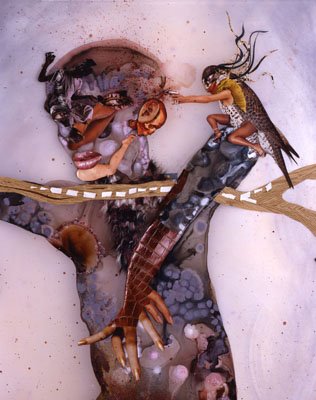
Bloody Old Head Games (detail), 2005.
at: SAN FRANCISCO MUSEUM OF MODERN ART
151 Third Street
December 16–April 02
Paul's Critique :Learning to look is part of being an artist. An artist looks at something, either internal or external, either knowingly or subconsciously and produces a reaction to that sensation. As a viewer of art we are an extra step away from the original conception. And by original conception I am not talking about an absolute by rather a synchronic moment. That moment will have had a history of many combined concepts to arrive at a solidarity of form.
When walking a person through looking at a piece of art, I will first gather their first impressions and then ask them to notice specific parts of the picture – until it is apparent that a complete picture a grouping of distinct features. Sometimes a viewer because of their past histories may see and feel emotive energies that I do not. The key I always emphasis is that a solid work of art is a communication between the artist and the art viewer. The physical work stands as a code. It is a code that there is no decided meaning. If the artist feels ill, they might be better to write down `words’ rather than attempt to communicate with images. By abandoning language, they allow `the unspeakable’ to enter into the dialogue. By unspeakable, I refer to sensations that have no clear words that define them.
Knowing nothing about the artist, or the painting, and viewing it `freshly I can only express my personal feelings. First impressions: – it seems peaceful, it is figurative, it is not about depicting beauty, and there are two characters represented and a tree branch.
On closer inspection we see that this is not a peaceful scene. The smaller character seems to be shooting the larger. The larger character has feminine lips. The feminine hand has six oddly joined fingers coming out of a reptilian fore arm. The head of the larger picture is made up of other images. Reminiscent of Giuseppe Arcimboldo [1527-93] ( who long after his death had a strong influence on Dali)
The branch is in the upper two third of the picture and has white dashes along it, it reads to me as a code for crossing the line. Or for the larger figure the possibility of escape.
The second character, much smaller is a human morphed bird creature. It takes a dramatic pose. To me, in my perception, the pose is authoritarian. This is a David killing a Goliath depiction. Yet, the Goliath, possibly because of her feminine attributes does not come across to me as being criminal, so much as being distorted, possibly sick. There is a sense that we are to feel sympathetic for the larger figure.
As a total composition, after closer viewing has a surreal nightmarish quality. The soft tonality goes against the brutality of the story. The composition feels balanced even though it is made up of incongruous parts. It is technically well done picture. It has a recognizable storyline (though not explicit). It has interesting textural effects from the dotted background to the one figure being created out of unusual coloring while the second is done more representational realistic.
INSIDERS VIEWS:
"Abuse of power comes as no surprise, as Jenny Holzer so lucidly put it some twenty-five years ago, and it remains a fitting slogan for the current geopolitical climate. Wangechi Mutu's skin-toned collages and body-referencing installation addresses the same subject—misused authority—with a range of heated corporeal references. Her site-specific installation, titled The Chief's Lair Is a Bloody Mess, includes two substantial collages, a series of sculptures, and wall works, and manages to address the dour tenor of the times by including wine bottles that drip their contents to the floor in blood-like splatters, infusing the gallery with earthy odors and Catholic subtexts. The bottles are suspended above a series of early American chairs with grafted-on leg extensions that make them seem like rickety thronelike spawn of a Louise Bourgeois spider. They face a truly dazzling constellation of red-tinted "wounds" that are gouged right out of a looming gallery wall. It's difficult not to think of violence in Iraq, though unlike our regulated media, Mutu pictures it with passion, color, and difficult truth.
—Glen Helfand"
No comments:
Post a Comment